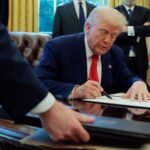New York
CNN
—
US stocks were volatile Wednesday after China announced significant retaliation and the European Union announced countermeasures against President Donald Trump’s enormous “reciprocal” tariffs that went into effect earlier in the day, upending global trade.
China’s new tariffs on US goods are 84%, matching the additional tariff the Trump administration just placed on the world’s second-biggest economy. Trump’s so-called reciprocal tariffs, America’s largest in a century, place massive across-the-board import taxes, some as high as 50%, on dozens of nations. China, an extreme outlier, now faces a US tariff of at least 104%, compounding the new tariffs with ones already in place.
US stocks briefly surged in the morning before bouncing around during a choppy day of trading. As of midday, the Dow hovered around the flatline and was up 50 points, or 0.13%. Similarly, the S&P 500 was up just 0.2% after fluctuating between gains and losses. Meanwhile, the tech-heavy Nasdaq was up 0.9%, though off its highest level of the day.
Just after the opening bell Trump posted on his social media platform Truth Social: “BE COOL!” and “This is a great time to buy!!!”
Tech stocks like Apple (AAPL), Nvidia (NVDA), Tesla (TSLA) and Palantir (PLTR) all briefly surged more than 3%, signaling investors might be bargain shopping while stocks are relatively cheap. The boost in stocks could prove fleeting, however, as investors continue to reckon with the extent of the president’s trade war.
The EU on Wednesday announced its first countermeasures against tariffs imposed by the United States, after member states approved a proposal made in response to the 25% tariff the US placed on the EU’s steel and aluminum exports. It said it would start to collect duties from April 15, stressing that “these countermeasures can be suspended at any time, should the US agree to a fair and balanced negotiated outcome.”
The S&P 500 is on the precipice of bear market territory, coming close to a stunningly rapid drop of 20% from the all-time high it hit just seven weeks ago on February 19. If the US stock market closes in bear market territory, it will end a bull run that has been ongoing since the peak of the inflation crisis in mid-October 2022 — marking the second-fastest decline from a record high to a bear market in the seven-decade history of the S&P 500. Only the Covid pandemic sent stocks into a bear market at a faster clip.
Fear has gripped investors across the world as the tariffs threaten to plunge the global and US economies into a recession this year. Businesses and consumers will end up footing those massive tariff bills, and uncertainty has led to a slowdown in hiring and consumer spending.
Japan’s Nikkei index closed 4% down, while Hong Kong’s Hang Seng finished marginally higher. On Monday, the Hang Seng tanked in a 13% rout – the biggest daily decline for the index since the 1997 Asian financial crisis.
South Korea’s benchmark Kospi index headed into bear market territory on Wednesday, a decline of 20% from a recent peak, after the country announced $1.3 billion in emergency support measures for its auto industry as it seeks to mitigate the blow of the Trump administration’s tariffs. The index closed 1.7%, falling about 20% from a peak reached in July 2024.
Markets in Taiwan also fell sharply. But the Shanghai stock market closed more than 1% higher, an outlier in a sea of red Wednesday.
In Europe, the region’s benchmark STOXX 600 index was down 3.45%. France’s CAC index was down 3.34% and Germany’s DAX was 2.96% lower. London’s FTSE 100 index was trading 2.92% lower.
Oil tumbles, bonds are acting strangely
Meanwhile, US oil tumbled 6% to $56 a barrel, while the global benchmark Brent crude fell below $60 a barrel — both their lowest levels since February 2021. Oil prices have plunged as investors fear a global recession could sap demand for travel, transportation and shipping – all of which require fuel.
Instead, investors have poured money into some traditional safe-havens, such as gold. Gold spot prices rose 3%.
But, curiously, US Treasury yields have risen in recent days as investors have sold off bonds. The benchmark 10-year yield, which fell below 4% earlier in the week, is now 4.4% — a rise of 0.1 percentage points from Tuesday’s closing yield.
Typically, in times of crisis, investors pour money into longer-term bonds in hopes that the short-term market problems are solved in the long run. But the bond market, like the stock market, has been shaken by extreme volatility in recent days, and some investors are heading for the exits.
Deutsche Bank analysts on Wednesday said the mass exodus from Treasury bonds may signal weakening demand for US-backed assets — traditionally viewed as the gold standard for safety, because it has the backing of the US government.
But in a trade war, investors may be fearful that America could lose its special standing in the world – an opinion echoed by JPMorgan CEO Jamie Dimon in his shareholder letter earlier this week. And foreign governments negotiating with Trump on trade may threaten to sell off their massive Treasury hoards, hurting America’s ability to borrow money to pay for its significant budget deficit.
“A policy objective of reducing bilateral trade imbalances is functionally equivalent to lowering demand for US assets as well,” said Deutsche Bank analysts said in a note to investors.
The US dollar index, which measure’s the dollar’s strength against six foreign currencies, tumbled 0.8% on Wednesday, continuing a broad weakening this year that can serve as a warning sign about waning investor confidence in the United States.
Surging volatility
The CBOE volatility index, also known as the “VIX” and Wall Street’s “fear gauge,” rose 4% and surpassed 50 — a level the index has only surpassed twice before: During the early stages of the Covid pandemic in March and April 2020 and the 2008-2009 financial crisis that brought on the so-called Great Recession.
The VIX is perhaps the best-known measure of market sentiment. It measures expected price fluctuations or volatility in the S&P 500 Index options over the next 30 days. The VIX often surges on days when the broader market sinks — and rallies when stocks rise. But over time, the VIX tends to be lower in bull markets and higher when the bears are in control.
Bearish sentiment is pervasive across the market lately. CNN’s Fear and Greed Index has pointed solidly to “Extreme Fear” in recent days — nearing the lowest point on its scale. The S&P 500 is close to bear market territory, and the Nasdaq and Russell 2000 are already in a bear.
President Donald Trump delivers remarks on tariffs in the Rose Garden at the White House in Washington, DC, on April 2.
Related article
Trump’s massive ‘reciprocal’ tariffs are now in place, upending global trade
Volatility works in both directions, and Monday and Tuesday are good examples. The market surged and tanked and bounced in every direction during the day as news — and even some fake news Monday — about Trump’s potential plans for tariffs made its way through Wall Street.
“The US and China are now locked into a trade war without either likely to back down at the moment,” Susannah Streeter, head of money and markets at Hargreaves Lansdown told CNN. “What you’re seeing in investors being extremely skittish which is why (there are) big fluctuations.”
In an afternoon press conference Tuesday, White House Press Secretary Karoline Leavitt said China had missed its deadline to peel back a 34% retaliatory tariff imposed on US goods Friday. So, the Trump administration nearly doubled its additional tariff on China Wednesday morning.
That means all Chinese goods coming into the United States will receive a minimum 104% tariff. Many other nations that avoided the so-called reciprocal tariffs – which aren’t really reciprocal – still face a 10% universal tariff that the Trump administration imposed on Saturday.
This is a developing story and will be updated
CNN’s James Frater and Christian Edwards contributed reporting















